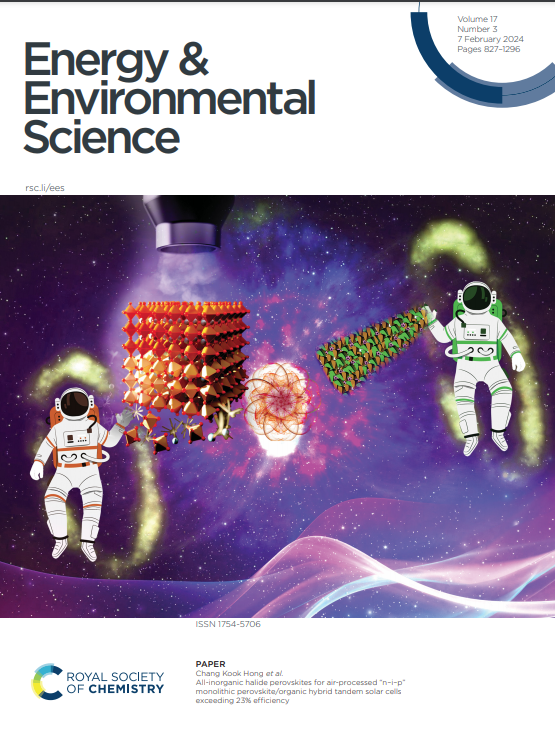通过原位界面构建加强剥离/电镀行为的对称性,实现长效锌金属电池
IF 32.4
1区 材料科学
Q1 CHEMISTRY, MULTIDISCIPLINARY
引用次数: 0
摘要
锌金属电池(ZBs)被认为是下一代储能系统的理想候选电池。锌金属电池的循环可逆性与最初剥离过程中锌阳极的界面演变密切相关。在本文中,剥离/电镀行为的不对称性被认为是导致 ZB 短路和失效的罪魁祸首,原因是树枝状 Zn 的不可控生长。因此,设计了一种含有 N,N′-二甲基丙烯脲(DU)的电解液来调节初始剥离行为,以提高锌阳极的循环可逆性。具体来说,DU 可吸收 Zn 表面的高氯酸盐阴离子(ClO4-),构建初始缓冲固体-电解质间相,从而降低剥离能垒并调节剥离动力学。与 DU 一起形成的贫水溶解结构 Zn[DU]2[ClO4]2[H2O]2 进一步增强了锌阳极剥离/电镀行为的对称性。在上述基础上,锌阳极可实现 6000 小时以上的可逆循环,NH4V4O10|||锌全电池表现出 5000 个循环以上的循环稳定性,容量保持率高达 85.3%。即使在 3 的低 N/P 比下,NH4V4O10||Zn 电池在循环 300 次后仍能保持 91.54% 的原始容量。这项研究为通过电解质化学调节锌阳极的剥离/电镀对称性提供了重要见解,促进了锌电池储能系统的应用。本文章由计算机程序翻译,如有差异,请以英文原文为准。
Reinforcing the Symmetry of Stripping/plating Behavior via In-situ Interface Construction for Long-lasting Zinc Metal Batteries
Zn metal batteries (ZBs) are considered promising candidates for next-generation energy storage systems. Cyclic reversibility of ZBs is strictly associated with the interfacial evolution of the Zn anode during the initial stripping. In this contribution, the asymmetry of the stripping/plating behavior is identified as the culprit for short circuits and failure of ZBs due to the uncontrollable growth of dendritic Zn. Accordingly, an electrolyte containing N, N′‑dimethylpropyleneurea (DU) is designed to regulate the initial stripping behavior for enhancing the cyclic reversibility of Zn anode. Specifically, DU absorbs on the Zn surface to concentrate perchlorate anions (ClO4−), constructing an initial buffer solid-electrolyte interphase to reduce the stripping energy barrier and regulate the stripping kinetics. With DU, a water-poor solvated structure, Zn[DU]2[ClO4]2[H2O]2, further enhances the symmetry of stripping/plating behavior of Zn anode. On the above basis, Zn anode enables reversible cycling for over 6000 hours, and NH4V4O10||Zn full cell exhibits cycling stability over 5000 cycles with a capacity retention of 85.3%. Even at a low N/P ratio of 3, NH4V4O10||Zn cell retains 91.54% of original capacity after 300 cycles. This study provides crucial insight into regulating stripping/plating symmetry of Zn anode via electrolyte chemistry, fostering applications of ZBs energy storage systems.
求助全文
通过发布文献求助,成功后即可免费获取论文全文。
去求助
来源期刊

Energy & Environmental Science
化学-工程:化工
CiteScore
50.50
自引率
2.20%
发文量
349
审稿时长
2.2 months
期刊介绍:
Energy & Environmental Science, a peer-reviewed scientific journal, publishes original research and review articles covering interdisciplinary topics in the (bio)chemical and (bio)physical sciences, as well as chemical engineering disciplines. Published monthly by the Royal Society of Chemistry (RSC), a not-for-profit publisher, Energy & Environmental Science is recognized as a leading journal. It boasts an impressive impact factor of 8.500 as of 2009, ranking 8th among 140 journals in the category "Chemistry, Multidisciplinary," second among 71 journals in "Energy & Fuels," second among 128 journals in "Engineering, Chemical," and first among 181 scientific journals in "Environmental Sciences."
Energy & Environmental Science publishes various types of articles, including Research Papers (original scientific work), Review Articles, Perspectives, and Minireviews (feature review-type articles of broad interest), Communications (original scientific work of an urgent nature), Opinions (personal, often speculative viewpoints or hypotheses on current topics), and Analysis Articles (in-depth examination of energy-related issues).
 求助内容:
求助内容: 应助结果提醒方式:
应助结果提醒方式:


